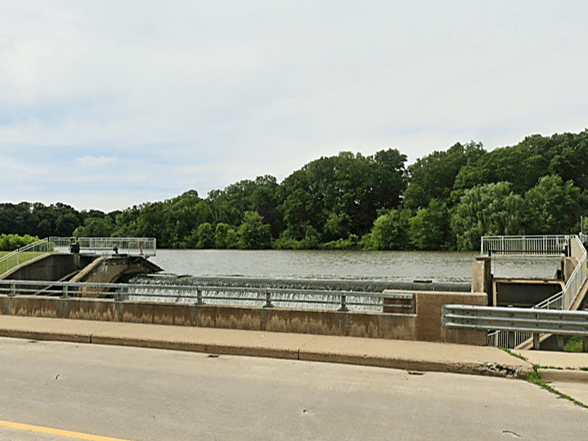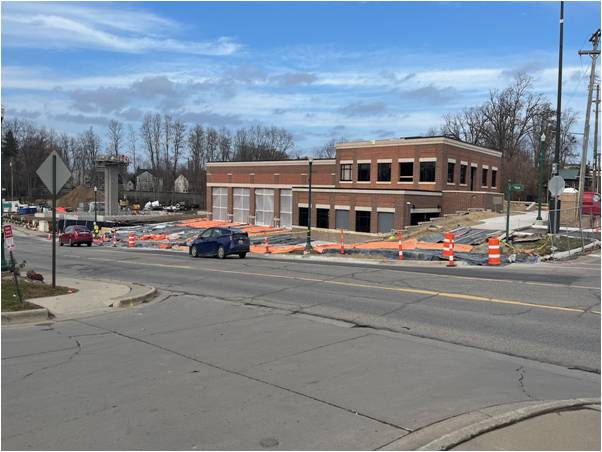City officials review a feasibility study outlining the costs and environmental impact of removing or rehabilitating the Saline River Dam.
Photo: Saline River Dam: Google Streetview
The future of the Saline River Dam took center stage at the Saline City Council meeting on March 17, as city officials and engineers presented a feasibility study outlining the costs, risks, and environmental impacts of both preserving and removing the dam.
Interim City Manager Elle Cole framed the discussion as a pivotal decision for the city’s future. “Tonight, we’re tackling a tough issue that’s foundational as it is forward-thinking. It’s our dam’s future. This isn’t just about infrastructure. It’s about safety, sustainability, and data-driven smart investments in our city.”
Condition of the Dam and Cost Considerations
City Engineer Tesha Humphriss outlined the aging structure’s current state, explaining that the dam, originally constructed in 1935 with modifications in 1973, requires significant investment to remain operational. “We need to invest at least a million dollars in this dam,” she stated, adding that potential long-term costs for rehabilitation could reach $7 to $8 million.
One of the key concerns is the deterioration of the concrete. “The concrete is just getting old. Right here you can see some exposed rebar that just continues to further deterioration of the walls,” Humphriss said while presenting images from a recent structural inspection.
Feasibility of Dam Removal
The feasibility study, funded by a state grant, examined the potential benefits of dam removal, citing environmental improvements and reduced long-term costs.
The study found that removing the dam would cost between $4.5 to $6 million, largely due to sediment management. “The sediment has built up… just cleaning it up right now, as it is, would just—that’s the material costs,” she explained, noting that dredging could cost between $2.5 and $5 million depending on the method used.
Humphriss also addressed concerns about downstream impact, stating, “The downstream impacts from removal are minimal to none.”
Community and Historical Considerations
The dam and adjacent Mill Pond Park have historical and recreational significance in Saline. While removal would alter the landscape, officials reassured the public that the area would remain a community space. “Mill Pond is going to stay a park no matter what,” Humphriss confirmed.
Councilmember Nicole Rice requested additional case studies from similar Henry Ford-era dams across the state, stating, “Have any of the other Henry Ford dams been removed or rehabilitated? What does that look like? Can you provide a couple of examples so that as we get further down the road and start talking about these things, we have either some rehabilitation examples of these types of dams and some removal examples of these types of dams?”
Funding and Next Steps
The council discussed potential funding sources for either rehabilitation or removal, though grant opportunities appear to favor removal projects. “A lot of them are more favorable for removal. For rehabilitation, a lot of times the funds go to high-risk dams to prevent that liability downstream,” Humphriss noted.
Councilmember Janet Dillon emphasized the need for financial planning regardless of the decision. “Would it be in the best interest of the city that we should start earmarking with every budget… because, you know, grants are what I call hopes and dreams?” she asked, urging the city to prepare for costs that may not be covered by external funding.
Councilmembers also raised concerns about long-term impacts, including changes to floodplain designations and insurance costs. “I think one of the really important parts of this conversation is, if there was a dam failure, what would the impact for that be? Both financially impact the environment,” said Councilmember Jenn Harmount.
Public Engagement and Timeline
The city is in the early stages of decision-making and encourages public input. “We are simply acknowledging receipt and accepting the dam feasibility study that was presented this evening,” said Mayor Brian Marl. “We welcome additional feedback if you have it.”
Humphriss noted that dam removal projects typically take five to ten years to complete and that a final decision is not imminent. “We’re at the very first phase of public engagement,” she said, urging residents to review the feasibility study and submit feedback.



 8123 Main St Suite 200 Dexter, MI 48130
8123 Main St Suite 200 Dexter, MI 48130


